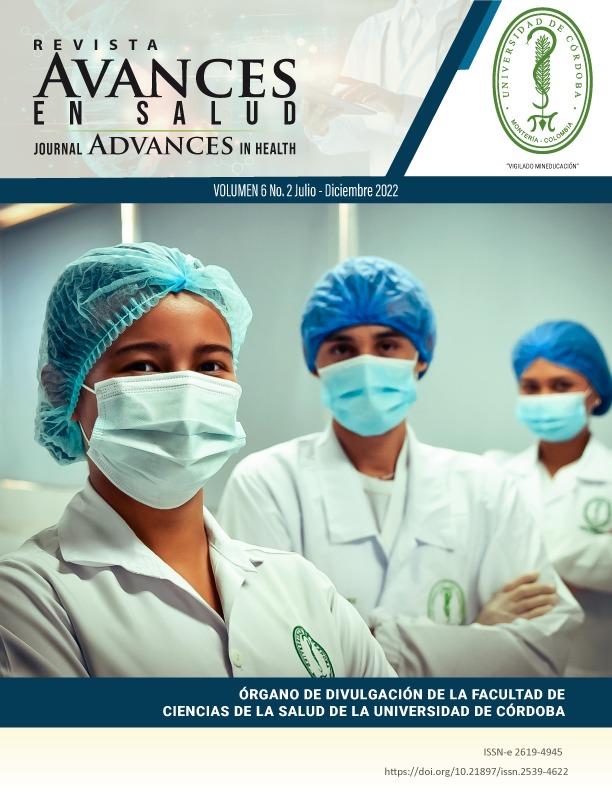Claves del bienestar: Una mirada desde la neurociencia
KEYS TO WELL-BEING: A NEUROSCIENTIFIC PERSPECTIVE

Esta obra está bajo una licencia internacional Creative Commons Atribución-CompartirIgual 4.0.
Mostrar biografía de los autores
Objetivo Describir desde las neurociencias los factores claves para gozar de bienestar y salud cerebral a través de una revisión sistemática de literatura científica. Materiales y métodos investigación de corte cualitativo de revisión sistemática de artículos en las bases de datos de Scopus, ScienceDirect y Google Scholar. La búsqueda incluyo referencias publicadas a partir del año 2006 en idiomas español e inglés que presentaran información científica desde las neurociencias sobre bienestar, felicidad, ejercicio, nutrición y salud cerebral Resultados Un total de 593 referencias fueron recuperadas, de las cuales 62 fueron seleccionadas para su análisis. Se hallaron estudios relevantes y actualizados acerca del estilo de vida de los seres humanos, y el impacto de este en la salud y el bienestar en general. Para ello se tomaron en cuenta documentos en los que se identificaron hábitos, conductas y comportamientos que podrían resultar beneficiosos o perjudiciales para el bienestar en general y en especial para la salud cerebral. Conclusiones El bienestar general y una buena salud cerebral están relacionados con diversos factores biológicos, socioemocionales y culturales, entre los que se destacan la felicidad, el agradecimiento, las relaciones sociales y afectivas, la nutrición, la actividad física y el sueño.
Visitas del artículo 594 | Visitas PDF
Descargas
- REFERENCIAS
- Lee DH, Seo SW, Roh JH, Oh M, Oh JS, Oh SJ, et al. Effects of cognitive reserve in Alzheimer’s disease and cognitively unimpaired individuals. Front Aging Neurosci [Internet]. 2021; 13 (febrero):1-13. Disponible en: http://dx.doi.org/10.3389/fnagi.2021.784054
- Andel R, Vigen C, Mack WJ, Clark LJ, Gatz M. The effect of education and occupational complexity on rate of cognitive decline in Alzheimer’s patients. J Int Neuropsychol Soc [Internet]. 2006; 12(1):147–152. Disponible en: http://dx.doi.org/10.1017/S1355617706060206
- Richards M, Sacker A. Lifetime antecedents of cognitive reserve. J Clin Exp Neuropsychol [Internet]. 2003; 25(5):614–624. Disponible en: http://dx.doi.org/10.1076/jcen.25.5.614.14581
- Colombo B, Antonietti A, Daneau B. The relationships between cognitive reserve and creativity. A study on American aging population. Front Psychol [Internet]. 2018; 9 (mayo):1-11. Disponible en: http://dx.doi.org/10.3389/fpsyg.2018.00764
- Stern Y. Cognitive reserve in ageing and Alzheimer’s disease. Lancet Neurol [Internet]. 2012;11(11):1006–1012. Disponible en: http://dx.doi.org/10.1016/S1474-4422(12)70191-6
- Stern Y. Cognitive reserve. Neuropsychologia [Internet]. 2009;47(10):2015–28. Disponible en: http://dx.doi.org/10.1016/j.neuropsychologia.2009.03.004
- Stern Y. Cognitive reserve and Alzheimer disease. Alzheimer Dis Assoc Disord [Internet]. 2006; 20(2):112–117. Disponible en: http://dx.doi.org/10.1097/01.wad.0000213815.20177.19
- Stern Y, Gurland B, Tatemichi TK, Tang MX, Wilder D, Mayeux R. Influence of education and occupation on the incidence of Alzheimer’s disease. JAMA [Internet]. 1994; 271 (13):1004–1010. Disponible en: http://dx.doi.org/10.1001/jama.1994.03510370056032
- Scarmeas N, Levy G, Tang MX, Manly J, Stern Y. Influence of leisure activity on the incidence of Alzheimer’s disease. Neurology [Internet]. 2001; 57 (mayo) (12):2236–2242. Disponible en: http://dx.doi.org/10.1212/wnl.57.12.2236
- Valenzuela MJ, Sachdev P. Brain reserve and dementia: a systematic review. Psychol Med [Internet]. 2006; 36 (abril) (4):441–454. Disponible en: http://dx.doi.org/10.1017/S0033291705006264
- Bialystok E. Bilingualism: Pathway to cognitive reserve. Trends Cogn Sci [Internet]. 2021;25(5):355–64. Disponible en: http://dx.doi.org/10.1016/j.tics.2021.02.003
- Mateos-Aparicio P, Rodríguez-Moreno A. The impact of studying brain plasticity. Front Cell Neurosci [Internet]. 2019; 13 (febrero): 1-5. Disponible en: http://dx.doi.org/10.3389/fncel.2019.00066
- Sophie Su Y, Veeravagu A, Grant G. Neuroplasticity after Traumatic Brain Injury. In: Laskowitz D, Grant G, editors. Boca Raton (FL); 2016.
- Hara Y. Brain plasticity and rehabilitation in stroke patients. J Nippon Med Sch [Internet]. 2015; 82 (1):4–13. Disponible en: http://dx.doi.org/10.1272/jnms.82.4
- Diener E, Lucas RE, Oishi S. Advances and open questions in the science of subjective well-being. Collabra Psychol [Internet]. 2018; 4 (1):1-49. Disponible en: http://dx.doi.org/10.1525/collabra.115
- Thorpe AE. Inquests Without Medical Witnesses. Vol. 144, The Lancet. 1894. 1245 p.
- Balasubramanian S, Cashin P. Gross national happiness and macroeconomic indicators in the kingdom of Bhutan. IMF Work Pap [Internet]. 2019; 19(15):1. Disponible en: http://dx.doi.org/10.5089/9781484389713.001
- Ukai AK. Gross National Happiness-Based Economic Growth Recommendations for Private Sector Growth Consistent with Bhutanese Values. 2016;40. Disponible en: https://ash.harvard.edu/files/ash/files/gross_national_happiness-based_economic_growth_-_allen_koji_ukai_-_final.pdf
- Seligman MEP. Authentic happiness: Using the new positive psychology to realize your potential for lasting fulfillment. Cammeray, NSW, Australia: Simon & Schuster; 2002; 1-93.
- Seligman MEP. Can happiness be taught? Daedalus [Internet]. 2004; 133(2):80–87. Disponible en: http://dx.doi.org/10.1162/001152604323049424
- Umberson D, Montez JK. Social relationships and health: a flashpoint for health policy. J Health Soc Behav [Internet]. 2010;51 Suppl: S54-S66. Disponible en: http://dx.doi.org/10.1177/0022146510383501
- Ozbay F, Johnson DC, Dimoulas E, Morgan CA, Charney D, Southwick S. Social support and resilience to stress: from neurobiology to clinical practice. Psychiatry (Edgmont). [Internet]. 2007;4(5):35–40. Disponible en: http://www.ncbi.nlm.nih.gov/pubmed/20806028%0Ahttp://www.pubmedcentral.nih.gov/articlerender.fcgi?artid=PMC2921311
- Conversano C, Rotondo A, Lensi E, Della Vista O, Arpone F, Reda MA. Optimism and its impact on mental and physical well-being. Clin Pract Epidemiol Ment Health [Internet]. 2010; 6(1):25–29. Disponible en: http://dx.doi.org/10.2174/1745017901006010025
- Loonen AJM, Ivanova SA. Circuits regulating pleasure and happiness: The evolution of the amygdalar-hippocampal-habenular connectivity in vertebrates. Front Neurosci [Internet]. 2016; 10 (noviembre):1-17. Disponible en: http://dx.doi.org/10.3389/fnins.2016.00539
- Berridge KC, Kringelbach ML. Pleasure systems in the brain. Neuron [Internet]. 2015; 86(3):646–64. Disponible en: http://dx.doi.org/10.1016/j.neuron.2015.02.018
- Wise RA. Dopamine and reward: the anhedonia hypothesis 30 years on. Neurotox Res [Internet]. 2008;14(2–3):169–183. Disponible en: http://dx.doi.org/10.1007/BF03033808
- Graff-Radford J, Williams L, Jones DT, Benarroch EE. Caudate nucleus as a component of networks controlling behavior. Neurology [Internet]. 2017; 89(21):2192–2197. Disponible en: http://dx.doi.org/10.1212/WNL.0000000000004680
- 71 . Lykken D, Tellegen A. Happiness is a stochastic phenomenon. Psychol Sci [Internet]. 1996;7(3):186–189. Disponible en: http://dx.doi.org/10.1111/j.1467-9280.1996.tb00355.x
- George LK. Still happy after all these years: research frontiers on subjective well-being in later life. J Gerontol B Psychol Sci Soc Sci [Internet]. 2010;65B (3):331–339. Disponible en: http://dx.doi.org/10.1093/geronb/gbq006
- Veenhoven R. Healthy happiness: effects of happiness on physical health and the consequences for preventive health care. J Happiness Stud [Internet]. 2008;9(3):449–469. Disponible en: http://dx.doi.org/10.1007/s10902-006-9042-1
- Tinkler L. The office for national statistics experience of collecting and measuring subjective well-being. Stat Transit New Ser [Internet]. 2015;16(3):373–396. Disponible en: http://dx.doi.org/10.21307/stattrans-2015-021
- Kahneman D, Deaton A. High income improves evaluation of life but not emotional well-being. Proc Natl Acad Sci U S A [Internet]. 2010;107(38):16489–16493. Disponible en: http://dx.doi.org/10.1073/pnas.1011492107
- Dunn EW, Aknin LB, Norton MI. Spending money on others promotes happiness. Science [Internet]. 2008; 319(5870):1687–1688. Disponible en: http://dx.doi.org/10.1126/science.1150952
- Fowler JH, Christakis NA. Dynamic spread of happiness in a large social network: longitudinal analysis over 20 years in the Framingham Heart Study. BMJ [Internet]. 2008; 337 (diciembre):23-38. Disponible en: http://dx.doi.org/10.1136/bmj.a2338
- Vaillant GE. Triumphs of experience: The men of the Harvard grant study. Londres, Inglaterra: Belknap Press; 2015.
- Martin S. Authentic Happiness. Londres, Inglaterra: Simon & Schuster; 2004.
- Emmons RA, Crumpler CA. Gratitude as a human strength: Appraising the evidence. J Soc Clin Psychol [Internet]. 2000;19(1):56–69. Disponible en: http://dx.doi.org/10.1521/jscp.2000.19.1.56
- Wood AM, Joseph S, Maltby J. Gratitude uniquely predicts satisfaction with life: Incremental validity above the domains and facets of the five factor model. Pers Individ Dif [Internet]. 2008; 45(1):49–54. Disponible en: http://dx.doi.org/10.1016/j.paid.2008.02.019
- DeShea L. A Scenario-Based Scale of Willingness to Forgive. Individ Differ Res. 2003;1(3):201–217.
- Algoe SB, Gable SL, Maisel NC. It’s the little things: Everyday gratitude as a booster shot for romantic relationships. Pers Relatsh [Internet]. 2010;17(2):217–233. Disponible en: http://dx.doi.org/10.1111/j.1475-6811.2010.01273.x
- Kashdan TB, Breen WE. Materialism and diminished well–being: Experiential avoidance as a mediating mechanism. J Soc Clin Psychol [Internet]. 2007; 26(5):521–539. Disponible en: http://dx.doi.org/10.1521/jscp.2007.26.5.521
- Fox GR, Kaplan J, Damasio H, Damasio A. Neural correlates of gratitude. Front Psychol [Internet]. 2015; 6:1491. Disponible en: http://dx.doi.org/10.3389/fpsyg.2015.01491
- Fox SE, Levitt P, Nelson CA 3rd. How the timing and quality of early experiences influence the development of brain architecture. Child Dev [Internet]. 2010;81(1):28–40. Disponible en: http://dx.doi.org/10.1111/j.1467-8624.2009.01380.x
- Walker SP, Wachs TD, Gardner JM, Lozoff B, Wasserman GA, Pollitt E, et al. Child development: risk factors for adverse outcomes in developing countries. Lancet [Internet]. 2007; 369(9556):145–157. Disponible en: http://dx.doi.org/10.1016/S0140-6736(07)60076-2
- Wachs TD, Georgieff M, Cusick S, McEwen BS. Issues in the timing of integrated early interventions: contributions from nutrition, neuroscience, and psychological research: Timing of integrated early interventions. Ann N Y Acad Sci [Internet]. 2014; 1308(1):89–106. Disponible en: http://dx.doi.org/10.1111/nyas.12314
- Kosheleff AR, Araki J, Tsan L, Chen G, Murphy NP, Maidment NT, et al. Junk food exposure disrupts selection of food-seeking actions in rats. Front Psychiatry [Internet]. 2018; 9 (agosto):1-10. Disponible en: http://dx.doi.org/10.3389/fpsyt.2018.00350
- Lowe CJ, Morton JB, Reichelt AC. Adolescent obesity and dietary decision making-a brain-health perspective. Lancet Child Adolesc Health [Internet]. 2020; 4(5):388–396. Disponible en: http://dx.doi.org/10.1016/S2352-4642(19)30404-3
- Trichopoulou A, Costacou T, Bamia C, Trichopoulos D. Adherence to a Mediterranean diet and survival in a Greek population. N Engl J Med [Internet]. 2003; 348(26):2599–2608. Disponible en: http://dx.doi.org/10.1056/NEJMoa025039
- Féart C, Samieri C, Barberger-Gateau P. Mediterranean diet and cognitive function in older adults. Curr Opin Clin Nutr Metab Care [Internet]. 2010; 13(1):14–8.1 Disponible en: http://dx.doi.org/10.1097/MCO.0b013e3283331fe4
- Zainuddin MSA, Thuret S. Nutrition, adult hippocampal neurogenesis and mental health. Br Med Bull [Internet]. 2012; 103(1):89–114. Disponible en: http://dx.doi.org/10.1093/bmb/lds021
- Spencer SJ, Korosi A, Layé S, Shukitt-Hale B, Barrientos RM. Food for thought: how nutrition impacts cognition and emotion. npj sci food [Internet]. 2017; 1(1):1-7. Disponible en: http://dx.doi.org/10.1038/s41538-017-0008-y
- Ahmad F, Hasan H, Abdelhady S, Fakih W, Osman N, Shaito A, et al. Healthy meal, happy brain: How diet affects brain functioning. Front Young Minds [Internet]. 2021; 9 (julio):1-9 Disponible en: http://dx.doi.org/10.3389/frym.2021.578214
- Ghazale H, Ramadan N, Mantash S, Zibara K, El-Sitt S, Darwish H, et al. Docosahexaenoic acid (DHA) enhances the therapeutic potential of neonatal neural stem cell transplantation post—Traumatic brain injury. Behav Brain Res [Internet]. 2018; 340 (marzo):1–13. Disponible en: http://dx.doi.org/10.1016/j.bbr.2017.11.007
- Deshmukh-Taskar PR, Nicklas TA, O’Neil CE, Keast DR, Radcliffe JD, Cho S. The relationship of breakfast skipping and type of breakfast consumption with nutrient intake and weight status in children and adolescents: the National Health and Nutrition Examination Survey 1999-2006. J Am Diet Assoc [Internet]. 2010; 110(6):869–878. Disponible en: http://dx.doi.org/10.1016/j.jada.2010.03.023
- De la Hunty A, Gibson S, Ashwell M. Does regular breakfast cereal consumption help children and adolescents stay slimmer? A systematic review and meta-analysis. Obes Facts [Internet]. 2013; 6(1):70–85. Disponible en: http://dx.doi.org/10.1159/000348878
- Sandercock GRH, Voss C, Dye L. Associations between habitual school-day breakfast consumption, body mass index, physical activity and cardiorespiratory fitness in English schoolchildren. Eur J Clin Nutr [Internet]. 2010; 64(10):1086–1092. Disponible en: http://dx.doi.org/10.1038/ejcn.2010.145
- Hoyland A, Dye L, Lawton CL. A systematic review of the effect of breakfast on the cognitive performance of children and adolescents. Nutr Res Rev [Internet]. 2009; 22(2):220–243. Disponible en: http://dx.doi.org/10.1017/S0954422409990175
- Ploughman M. Exercise is brain food: the effects of physical activity on cognitive function. Dev Neurorehabil [Internet]. 2008; 11(3):236–240. Disponible en: http://dx.doi.org/10.1080/17518420801997007
- Ratey JJ. Spark: The revolutionary new science of exercise and the brain. Little Brown and Company; 2008.
- Schoenfeld TJ, Rada P, Pieruzzini PR, Hsueh B, Gould E. Physical exercise prevents stress-induced activation of granule neurons and enhances local inhibitory mechanisms in the dentate gyrus. J Neurosci [Internet]. 2013; 33 (18):7770–7777. Disponible en: http://dx.doi.org/10.1523/JNEUROSCI.5352-12.2013
- Suzuki W, Fitzpatrick B. Healthy brain, happy life: A personal program to activate your brain and do everything better. Dey Street Books; 2016.
- Puterman E, Lin J, Blackburn E, O’Donovan A, Adler N, Epel E. The power of exercise: buffering the effect of chronic stress on telomere length. PLoS One [Internet]. 2010; 5 (5): e10837. Disponible en: http://dx.doi.org/10.1371/journal.pone.0010837
- Erickson KI, Voss MW, Prakash RS, Basak C, Szabo A, Chaddock L, et al. Exercise training increases size of hippocampus and improves memory. Proc Natl Acad Sci U S A [Internet]. 2011; 108(7):3017–3022. Disponible en: http://dx.doi.org/10.1073/pnas.1015950108
- Coles K, Tomporowski PD. Effects of acute exercise on executive processing, short-term and long-term memory. J Sports Sci [Internet]. 2008; 26(3):333–344. Disponible en: http://dx.doi.org/10.1080/02640410701591417
- Aberg MAI, Pedersen NL, Torén K, Svartengren M, Bäckstrand B, Johnsson T, et al. Cardiovascular fitness is associated with cognition in young adulthood. Proc Natl Acad Sci U S A [Internet]. 2009; 106(49):20906–20911. Disponible en: http://dx.doi.org/10.1073/pnas.0905307106
- Nissen C, Piosczyk H, Holz J, Maier JG, Frase L, Sterr A, et al. Sleep is more than rest for plasticity in the human cortex. Sleep [Internet]. 2021; 44(3):1-7 Disponible en: http://dx.doi.org/10.1093/sleep/zsaa216
- Xie L, Kang H, Xu Q, Chen MJ, Liao Y, Thiyagarajan M, et al. Sleep drives metabolite clearance from the adult brain. Science [Internet]. 2013; 342(6156):373–377. Disponible en: http://dx.doi.org/10.1126/science.1241224
- Colten HR, Altevogt BM. Sleep disorders and sleep deprivation: An unmet public health problem. Sleep Disorders and Sleep Deprivation: An Unmet Public Health Problem. 2006. 1–404 p.
- Rasch B, Born J. About sleep’s role in memory. Physiol Rev [Internet]. 2013; 93(2):681–766. Disponible en: http://dx.doi.org/10.1152/physrev.00032.2012
- Radwan B, Jansen G, Chaudhury D. Abnormal sleep signals vulnerability to chronic social defeat stress. Front Neurosci [Internet]. 2021; 14 (enero):1-16. Disponible en: http://dx.doi.org/10.3389/fnins.2020.610655
- Sin NL, Wen JH, Klaiber P, Buxton OM, Almeida DM. Sleep duration and affective reactivity to stressors and positive events in daily life. Health Psychol [Internet]. 2020; 39(12):1078–1088. Disponible en: http://dx.doi.org/10.1037/hea0001033
- Caccese JB, Iverson GL, Hunzinger KJ, Asken BM, Clugston JR, Cameron KL, et al. Factors associated with symptom reporting in U.s. service academy cadets and NCAA student athletes without concussion: Findings from the CARE consortium. Sports Med [Internet]. 2021; 51(5):1087–105. Disponible en: http://dx.doi.org/10.1007/s40279-020-01415-4
- Ferrie JE, Shipley MJ, Akbaraly TN, Marmot MG, Kivimäki M, Singh-Manoux A. Change in sleep duration and cognitive function: findings from the Whitehall II Study. Sleep [Internet]. 2011; 34(5):565–573. Disponible en: http://dx.doi.org/10.1093/sleep/34.5.565
- Peters R. Ageing and the brain. Postgrad Med J [Internet]. 2006; 82(964):84–88. Disponible en: http://dx.doi.org/10.1136/pgmj.2005.036665
- Lock S. Global council on brain health: Advancing international dialogue to promote well-being. Innov Aging [Internet]. 2017;1(suppl_1):40. Disponible en: http://dx.doi.org/10.1093/geroni/igx004.158








